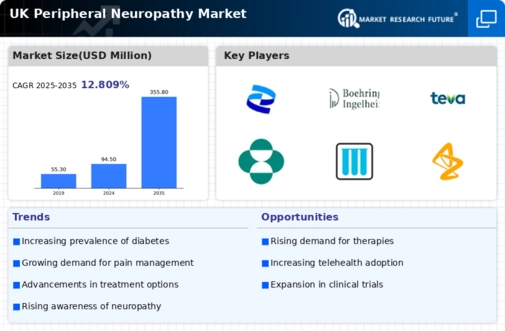The peripheral neuropathy market is characterized by a competitive landscape that is increasingly shaped by innovation, strategic partnerships, and a focus on patient-centric solutions. Key players such as Pfizer Inc (US), Johnson & Johnson (US), and AstraZeneca PLC (GB) are actively engaged in enhancing their product portfolios and expanding their market reach. Pfizer Inc (US) has been focusing on the development of novel therapies aimed at addressing neuropathic pain, which appears to be a significant growth driver in this sector. Meanwhile, Johnson & Johnson (US) is leveraging its extensive research capabilities to explore new treatment modalities, indicating a commitment to innovation that could redefine patient outcomes. AstraZeneca PLC (GB) is also positioning itself strategically by investing in digital health solutions, which may enhance patient engagement and adherence to treatment regimens, thereby shaping the competitive environment.
The business tactics employed by these companies reflect a nuanced understanding of the market's structure, which is moderately fragmented yet dominated by a few key players. Localizing manufacturing and optimizing supply chains are critical strategies that these companies are adopting to enhance operational efficiency and reduce costs. This collective influence of major players not only drives competition but also fosters an environment where innovation can thrive, as companies seek to differentiate themselves through unique offerings and improved patient experiences.
In October 2025, Pfizer Inc (US) announced a strategic collaboration with a leading biotechnology firm to develop a new class of pain management therapies specifically targeting peripheral neuropathy. This partnership is expected to accelerate the development timeline and enhance the therapeutic options available to patients, reflecting Pfizer's commitment to addressing unmet medical needs in this area. The strategic importance of this collaboration lies in its potential to position Pfizer as a leader in innovative pain management solutions, thereby strengthening its competitive edge.
In September 2025, Johnson & Johnson (US) launched a digital health platform designed to support patients with chronic pain conditions, including peripheral neuropathy. This initiative aims to provide personalized treatment plans and real-time monitoring, which could significantly improve patient outcomes. The strategic significance of this move is underscored by the growing trend towards digital health solutions, suggesting that Johnson & Johnson is keen to integrate technology into its therapeutic offerings, thereby enhancing its market position.
In August 2025, AstraZeneca PLC (GB) expanded its research and development efforts by establishing a new innovation hub focused on neurological disorders, including peripheral neuropathy. This initiative is indicative of AstraZeneca's long-term commitment to advancing treatment options in this field. The establishment of this hub may facilitate collaboration with academic institutions and startups, potentially leading to groundbreaking discoveries that could reshape the treatment landscape.
As of November 2025, the competitive trends in the peripheral neuropathy market are increasingly defined by digitalization, sustainability, and the integration of artificial intelligence (AI) into therapeutic development. Strategic alliances are becoming more prevalent, as companies recognize the value of collaboration in driving innovation. Looking ahead, it appears that competitive differentiation will evolve from traditional price-based competition to a focus on technological advancements, innovative treatment solutions, and reliable supply chains. This shift may ultimately enhance patient care and foster a more dynamic market environment.

















Leave a Comment